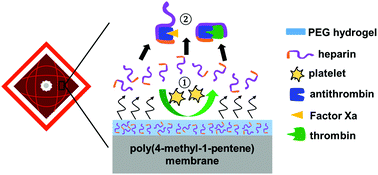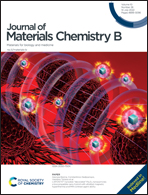Investigation of heparin-loaded poly(ethylene glycol)-based hydrogels as anti-thrombogenic surface coatings for extracorporeal membrane oxygenation
Abstract
Extracorporeal membrane oxygenation (ECMO), a critical life-sustaining tool, faces significant challenges for the maintenance of normal haemostasis due to the large volume of circulating blood continuously in contact with artificial surfaces, hyperoxia and excessive shear stresses of the extracorporeal circuit. From a biomaterials perspective, it has been hypothesised that drug eluting coatings composed of haemocompatible hydrogels loaded with an anticoagulant drug could potentially enhance the haemocompatibility of the circuit. Poly(ethylene glycol) (PEG) has been well established as a biocompatible and anti-fouling material with wide biomedical application. Unfractionated heparin is the most commonly used anticoagulant for ECMO. In the present study, the feasibility of using heparin-loaded PEG-based hydrogels as anti-thrombogenic surface coatings for ECMO was investigated. The hydrogels were synthesised by photopolymerisation using poly(ethylene glycol) diacrylate (PEGDA) as the crosslinking monomer and poly(ethylene glycol) methacrylate (PEGMA) as the hydrophilic monomer, with heparin loaded into the pre-gel solution. Factors which could affect the release of heparin were investigated, including the ratio of PEGDA/PEGMA, water content, loading level of heparin and the flow of fluid past the hydrogel. Our results showed that increased crosslinker content and decreased water content led to slower heparin release. The hydrogels with water contents of 60 wt% and 70 wt% could achieve a sustained heparin release by adjusting the ratio of PEGDA/PEGMA. The anticoagulation efficacy of the released heparin was evaluated by measuring the activated clotting time of whole blood. The hydrogels with desirable heparin release profiles were prepared onto poly(4-methyl-1-pentene) (PMP) films with the same chemical composition as the PMP ECMO membranes. The coatings showed sustained heparin release with a cumulative release of 70–80% after 7 days. Haemocompatibility tests demonstrated that PEG hydrogel coatings significantly reduced platelet adhesion and prolonged plasma recalcification time. These results suggest that heparin-loaded PEG hydrogels are potential anti-thrombogenic coatings for ECMO.



 Please wait while we load your content...
Please wait while we load your content...